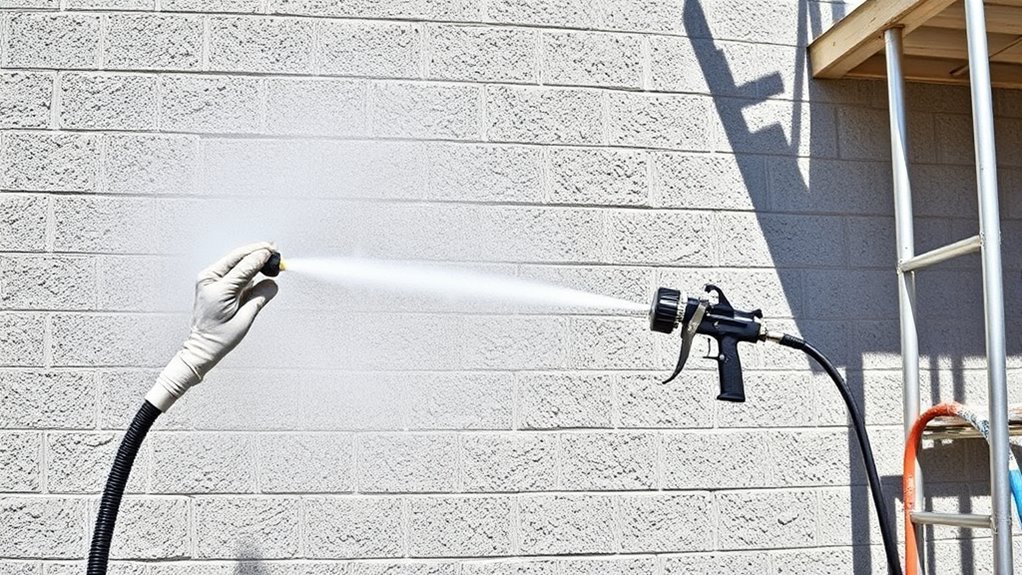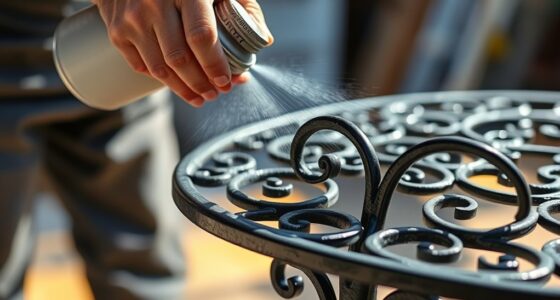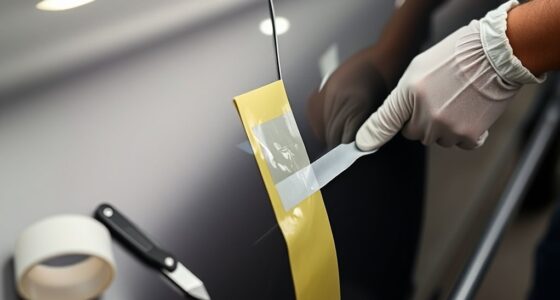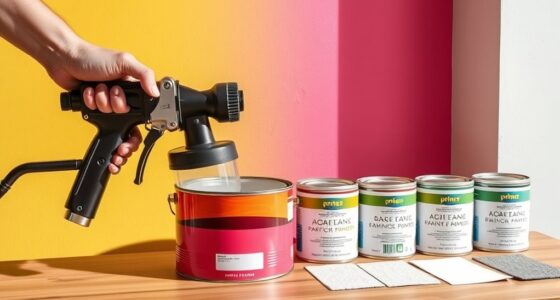To spray concrete block walls (CMU), start by cleaning the surface thoroughly, removing debris and loose material for better adhesion. Use a spray gun held 12-18 inches from the wall, applying multiple thin, overlapping coats with steady, even passes. Adjust and maintain your equipment correctly, including pressure and tip cleanliness, to avoid uneven coverage or drips. Always wear safety gear and ensure proper ventilation. Keep these tips in mind, and you’ll be on your way to a professional finish as you continue.
Key Takeaways
- Clean and prepare the CMU wall surface, removing debris and loose material for proper adhesion.
- Use a suitable spray gun with correct tip size, maintaining 12-18 inches distance for even coverage.
- Adjust spray pressure and keep equipment well-maintained to prevent drips, overspray, or uneven coats.
- Apply multiple thin, overlapping coats for a smooth, durable finish, inspecting and touching up as needed.
- Wear protective gear, ensure proper ventilation, and follow safety guidelines throughout the spraying process.

Spraying concrete block walls is an efficient way to achieve a smooth, durable finish quickly. When you’re planning to spray CMU (concrete masonry units), understanding proper finishing techniques is essential. These techniques help you create a professional-looking surface that resists weathering and damage. Before you start, take the time to prepare your workspace by removing debris and ensuring the wall surface is clean and free of loose material. This foundation will help the spray adhere evenly, reducing the need for extensive touch-ups later.
Proper preparation of the surface ensures even spray adhesion and a professional finish.
As you begin spraying, hold the spray gun at a consistent distance from the wall—usually about 12 to 18 inches—to maintain an even application. Move steadily in overlapping passes to prevent streaks and ensure uniform coverage. Keep the spray pattern consistent and avoid lingering in one spot, which could cause drips or uneven texture. If you want a smoother finish, you might consider applying multiple thin coats rather than one thick layer. This approach not only enhances the wall’s appearance but also improves adhesion and durability.
Using the right equipment and settings is critical. Adjust the pressure according to the manufacturer’s recommendations and the texture you desire. Too much pressure can cause overspray and waste material, while too little might result in an uneven coat. Keep the spray tip clean and replace it if it becomes clogged to maintain a consistent spray pattern. Once you finish spraying, inspect the wall for any missed spots or uneven areas, and touch them up as needed, always following best finishing techniques to achieve a professional look. Proper surface preparation also plays a vital role in ensuring the longevity and quality of the finish.
Safety precautions are essential throughout the process. Always wear personal protective equipment, including goggles, a respirator mask, gloves, and long-sleeved clothing to shield yourself from airborne particles and chemical fumes. Ensure proper ventilation in the workspace to prevent inhalation of dust and fumes. Keep a fire extinguisher nearby, especially if you’re working with flammable materials or equipment. Be cautious when handling and mixing the concrete or spray materials, following the manufacturer’s instructions carefully. Make sure your workspace is well-ventilated, and keep others at a safe distance to avoid accidental exposure.
Frequently Asked Questions
What Is the Best Spray Gun for Concrete Walls?
You should choose a pneumatic or airless spray gun for concrete walls, as these types handle thick materials well. Airless spray guns offer higher pressure and faster application, making them ideal for large surfaces. Make sure to use proper application techniques, like consistent distance and slow, steady passes, to achieve a smooth finish. Select a spray gun compatible with your project size and verify it can handle the viscosity of concrete for best results.
How Long Does a Sprayed Concrete Wall Typically Last?
A sprayed concrete wall can last 50 years or more if you consider durability factors like proper surface preparation, adequate curing, and high-quality materials. While some believe it might wear out faster, regular maintenance tips—such as sealing cracks and cleaning—can extend its lifespan. You’ll get the most out of your wall by ensuring professional application and routine inspections, helping it stand strong for decades.
Can I Spray Concrete Over Existing Painted Surfaces?
You can spray concrete over painted surfaces if you properly prepare the surface. First, clean and roughen the existing paint to guarantee good adhesion. Check paint compatibility; oil-based paints usually work better than latex. Removing loose or peeling paint is essential to prevent future issues. Proper surface preparation guarantees the sprayed concrete bonds well and minimizes peeling or cracking over time.
What Safety Gear Is Essential During Spraying?
Like a knight preparing for battle, you need your protective equipment to stay safe. You should wear a respirator or a mask to guarantee respiratory safety, preventing inhalation of harmful dust and fumes. Safety goggles protect your eyes from splatters, while gloves safeguard your hands. Ear protection is also wise if using loud equipment. With this gear, you shield yourself from potential hazards and confidently tackle your spraying project.
How Do I Repair a Damaged Sprayed Concrete Wall?
To repair a damaged sprayed concrete wall, first clean the area thoroughly, removing loose debris and dust. Then, prepare the concrete surface by roughening it slightly for better adhesion. Mix and apply a suitable patching compound, ensuring it blends seamlessly with the existing wall. Keep your spray gun well-maintained for smooth application, and, once dried, sand lightly if needed to achieve a uniform finish.
Conclusion
Now that you know how to spray concrete block walls, you’re well on your way to giving your project a fresh, professional look. Just remember, patience and attention to detail pay off in the end. Don’t rush the job—you’re better off taking your time than having to redo it later. With the right techniques, you’ll turn a rough wall into a smooth masterpiece. Keep at it, and you’ll see that good things come to those who wait.
Franz came aboard the Paint Sprayer Zone team with a background in both journalism and home renovation. His articulate writing style, combined with a passion for DIY projects, makes him an invaluable asset. Franz has a knack for breaking down technical jargon into easy-to-understand content, ensuring that even the most novice of readers can grasp the complexities of paint sprayers.










